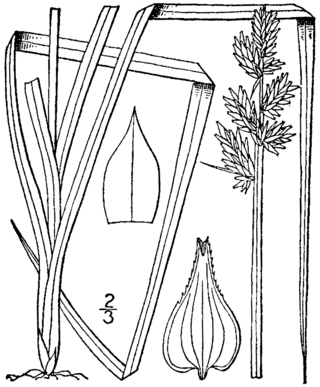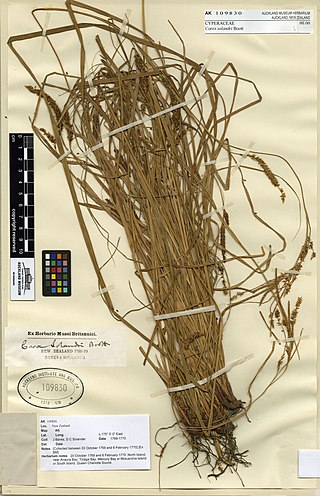Carex acutata is a species of sedge, a flowering plant in the family Cyperaceae. It was first formally named by Francis Boott in 1846. Carex acutata is native to South America. In Bolivia it occurs at elevations of 3,500–4,000 m (11,500–13,100 ft).

Carex alligata, the Hawaiʻi sedge, is a species of sedge that is endemic to Hawaii.
Carex amicta is a species of sedge that was first formally named by Francis Boott in 1867. It is native to South America, from Venezuela to Peru.
Carex andersonii is a species of sedge that was first described by Francis Boott in 1846. It is native to Chile and Argentina.
Carex aperta, known as Columbian sedge, is a species of sedge that was first described by Francis Boott in 1839. It is native to eastern Russia, northern China, western Canada, and the northwestern United States. It grows in wet meadows, along shorelines, and in other wet habitats.

Carex arctata, known as drooping woodland sedge, is a species of sedge native to eastern North America. It is sometimes called black sedge, compressed sedge, or drooping wood sedge. It occurs from Manitoba to the Maritimes in Canada, south to northwestern North Carolina, and west to Minnesota. Carex arctata grows in bogs, hardwood forests, and spruce forests.

Carex banksii is a species of flowering plant in the sedge family, Cyperaceae. Carex banksii is native to South America and was first formally named by Francis Boott in 1839.
Carex barbata is a Tasmanian species of sedge that was first formally named by Francis Boott in 1858, in his Illustrations of the genus Carex. A specimen collected in February 1839 by R. C. Gunn is the only known collection of this species. In 1909, it was reclassified as a variety of Carex gunniana, but Kew's Plants of the World Online maintains it as a separate species.
Carex bichenoviana, the plains sedge, is a species of sedge that was first formally named by Francis Boott in 1858. It is native to eastern Australia and has been introduced to New Zealand. It has previously been considered a variety of Carex pumila.

Carex conjuncta, known as soft fox sedge, is a species of sedge that was first formally named by Francis Boott in 1862. It is endemic to the central and eastern United States.
Carex gunniana is an Australia species of sedge that was first described in 1845 by Boott in the Proceedings of the Linnean Society of London. It is native to eastern Australia and Tasmania.

Carex lanceolata is a species of sedge, native to the eastern half of China, Mongolia, eastern Siberia, Korea, Sakhalin, and Japan. Its seeds are dispersed by ants.

Carex morrowii, the kan suge, Morrow's sedge, Japanese grass sedge or Japanese sedge, is a species of flowering plant in the family Cyperaceae. It is native to central and southern Japan, and has been introduced to Belgium, Denmark and Austria.
Carex purdiei is a tussock-forming species of perennial sedge in the family Cyperaceae. It is native to southern parts of Central America and northern parts of South America.

Carex solandri is a species of sedge that was first described by Francis Boott in 1853.

Carex stipata, variously called the prickly sedge, awl-fruited sedge, awlfruit sedge, owlfruit sedge, swamp sedge, sawbeak sedge, stalk-grain sedge and common fox sedge, is a species of flowering plant in the genus Carex, native to Canada, the United States, China, Korea, Japan, and Far Eastern Russia. It is a wetland obligate.

Carex breviculmis, called the Asian shortstem sedge, is a species of flowering plant in the genus Carex, native to Asia from the Indian subcontinent to Southeast Asia, China, Taiwan, Korea, Japan, north as far as Khabarovsk Krai, and Malesia, New Guinea, Australia, Norfolk Island and New Zealand. It has been introduced to the US state of Mississippi. Typically found in forests, it is quite shade tolerant.

Carex punctata, the dotted sedge, is a species of flowering plant in the genus Carex, native to Macaronesia, northwest Africa, southern, central, and northern Europe, and Turkey. Its chromosome number is 2n=68.

Carex virgata, the swamp sedge, is a species of flowering plant in the family Cyperaceae. It is native to Tasmania, New Zealand, and the Chatham Islands, and has been introduced to Great Britain. It is used in constructed wetlands for wastewater treatment.
Carex argyrantha, the hay sedge, is a species of flowering plant in the family Cyperaceae. It is native to eastern Canada and the east-central and northeastern United States, and has gone extinct in Delaware. It typically grows in rocky woodlands and on sandstone ledges and has potential for use on green roofs.










